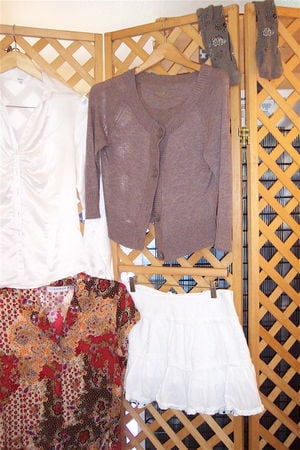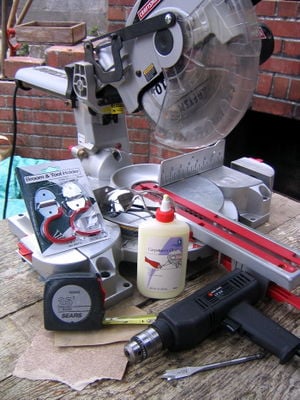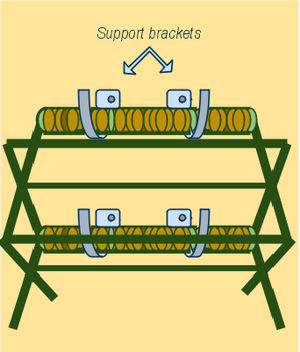Clothes drying

History[edit | edit source]
Traditionally clothes drying has taken place on clothes lines through solar evaporation and convection drying. This method has become the less common method in modern day homes replaced by drying machines which shorten the life span of most clothes by over-drying them[1] and rely on some for of non-renewable energy(gas/electric). The most common household dryer tends to be the least efficient adding even more to their carbon footprint[verification needed]. There are newer models with moisture sensors that will automatically stop heating at a specific humidity[verification needed].
Drying Basics[edit | edit source]
Clothes obtain moisture during their wash cycle, most of the water may be removed by either spinning off any excess or ringing it. That later being a bit hard on the clothes. What then is the best method for removing the last bit of moisture trapped in the material. Heat and air exchange are the two main components in this process lets look at the different options available.

Drying Concerns[edit | edit source]
Speed
- If you have a small amount of clothing and you need your clothes immediately after washing them than time is a definite concern. However if you have enough clothes to hold you for a couple days drying time really isn't all that important. This may be hard to remember. I've never seen line dry or indoor drying take more than a day or two.
Financial impact
- It is estimated that the average family has a usage of 392 loads of laundry per year, or just under 8 loads per week[2]"According to Procter & Gamble Co., the average American family does about 300 loads of laundry per year, or about six loads per week...The biggest way to cut the environmental impact of cleaning clothes, however, is to stop using a clothes dryer. Drying laundry outside on a line, Tesco says, will cut the carbon footprint of every load by a whopping 4.4 pounds."[3] and save on cost. These figures seem high to me since I only do maybe a low a week.
Environmental Impact
- "Drying, a process to remove water from a substance is one of the most frequently and widely used operating processes in daily life and is undeniably an energy-intensive operation. In developed countries, up to 12% of the total industrial energy use is consumed by drying.... Over-drying obviously wastes energy and may also undermine the quality and life of fabric. It was estimated that up to 33% energy saving can be achieved through the prevention of over-drying alone"[4]
Convenience
- How much time does the whole process take. Do you have electricity available or is time more valuable?

Effects on clothes
- Shrinking and wear and tear: Constant-Rate Drying Period(CRDP) Falling-Rate Drying Period(FRDP)
Humidity
- The moisture must have a way to escape:
According to the California Research Bureau's report on Indoor Mold the best way to prevent mold regulate humidity through ventilation. Without proper ventilation mold is extremely like to occur.[5] It is also important to consider your surrounding environment. In the CCAT building the walls are painted with natural protein based paints. Milk paint emits no VOC's, and it is slightly alkaline naturally inhibiting mold growth "perfect for humid environments and for straw bale homes"[6]
What you need[edit | edit source]
Make sure that the room you are drying your clothes in has proper ventilation since machine dryers have a exhaust tube a normal room may not have a high enough air exchange rate creating a great environment to grow mold in[7]

Possible alternative materials
- Bamboo
- Aluminum Poles
- Wood
- Cord
Tools
Screwdriver Hand Saw
Skills needed
Light Carpentry
Estimated time of construction
12 hours or less Your drying rack will most likely be different based off your climate, and needs.
Asses your needs based off of climate, space, time concerns. What is most important for you?
- The speed at which your clothes are dry? Stick with conventional dryer
- Preserving the longevity of your clothing? Try indoor hang drying
- Not using electricity or adding to the waste? Avoid drying machine and cheep dowel drying racks that will break within a year.
- Saving money? Try Line drying or a warm spot where hanging is easy.
- Not using much space? If you live in an apartment the old method the rotating line dry might work well.
Types of Drying[edit | edit source]
| System | Pros | Cons |
|---|---|---|
| Conventional Dryer (electric or gas) | Convenient, quick drying time, not weather dependent. | Uses electricity, expensive, needs hookups, wears out clothing faster, increases carbon footprint of each load. |
| Outdoor | Little to no initial cost, easy set up, fast in dry summers, little to no skills needed, no fuel or grid hookup needed. | Weather dependent, slow in humid environments, stiff clothing, fading of colors. |
| Indoor | Low initial cost, uses ambient heat, not stopped by weather(although may effect dry time), potentially slow dry, no fuel needed, no color fading or damage due to 'over drying'. | Potentially slow dry time, less convenient(slightly more time intensive), increased humidity in home. |
Construction instructions[edit | edit source]

Based on CCAT's needs I will be building a drying rack out of bamboo that will be located downstairs in the laundry room near the washer which is already used by the codirectors. The specific design has yet to be confirmed by CCAT.
The Next Steps[edit | edit source]
Building it!
What I found[edit | edit source]
I've been using my dry screen for 5 months now to cut my drying bill by more than half. It takes about a day for the clothes to dry two if it's cold & rainy, half a day if it's hot. I live in Arcata so one day of drying should be a average length for the most places. My clothes dry with few wrinkles and don't shrink, I still have to dry bed sheets since my apartment is too small for the inconvenience it would cause. So I'll throw my towels in the dryer after they have already dried with those to 'fluff' them. I love it and it's easier on the clothes.
Possible alternatives devices[edit | edit source]
- The outdoor 'umbrella' drying rack is popular in dryer climates.
- The 'accordion' pull out drying rack is sold online.
- Small fold up racks sold everywhere
- Note all of these can be constructed at home with a few basic tools instead of purchasing them
References[edit | edit source]
- ↑ http://www.sciencedirect.com
- ↑ Energy Star http://www.energystar.gov/index.cfm?fuseaction=clotheswash.display_column_definitions
- ↑ html The Wall Street Journal http://online.wsj.com/article/SB122304950601802565.
- ↑ http://www.sciencedirect.com
- ↑ California online Library http://www.library.ca.gov/crb/06/01/06-001.pdf
- ↑ Green by Design http://web.archive.org/web/20110520230647/http://greenbydesign.com/2008/11/10/milk-paint-safe-green-new-old-timey/
- ↑ Indoor Mold: A General Guide to Health Effects, Prevention, and Remediation Kenneth W. Umbach, Ph.D. Pamela J. Davis, R.N., P.H.N., 2006